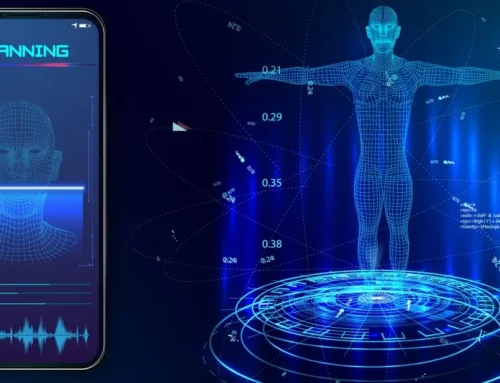IKIN, a leading provider of visual technology solutions for businesses and consumers, announced it has selected Android as its initial go-to-market platform to bring interactive holographic content to mobile apps, games and tools to the mobile marketplace. The company plans to roll out a comprehensive collection of hardware, software, mobile apps and developer tools to enable display of holograms through 4G and 5G mobile devices. The company expects to conduct its first field trials in 2020 with general availability anticipated for 2021.
You may recall, we asked if IKIN’s technology is the future of AR and VR after seeing an impressive demo in our offices.
IKIN has already surpassed a number of milestones for its RYZ family of products that will enable display and interaction with holograms on Android mobile devices. The solution is optimized for seamless performance across current networks and can fully utilize expanded transmission and bandwidth capacities that will be available as 5G services are introduced by wireless carriers around the world.
 “There is a common perception that holograms will place significant bandwidth demands on networks and devices,” said Taylor Scott, IKIN’s Chief Technology Officer. “Through IKIN’s optimization algorithms, we’ve created a solution that will have minimal impact on performance across current and future network technologies. We anticipate that interactive holographic engagement enabled through RYZ will delight users while efficiently leveraging network resources.”
“There is a common perception that holograms will place significant bandwidth demands on networks and devices,” said Taylor Scott, IKIN’s Chief Technology Officer. “Through IKIN’s optimization algorithms, we’ve created a solution that will have minimal impact on performance across current and future network technologies. We anticipate that interactive holographic engagement enabled through RYZ will delight users while efficiently leveraging network resources.”
IKIN’s RYZ product line – comprised of RYZ Framework, RYZ Accessory and RYZ mobile app – delivers volumetric rendering and display to mobile devices, empowering the touch control and inclusion of holograms in nearly any mobile app, game or tool. Moving beyond existing AR and VR technologies, RYZ displays holograms in ambient light without the use of goggles or other specialized equipment.
RYZ provides developers with a strong set of open SDKs and APIs that empower the incorporation of holographic elements and features into games, business applications and communications services in multiple design environments.

Joe Ward, IKIN’s Chief Executive Officer
“IKIN’s technology will work on nearly any mobile device, but we chose to go forward with Android for the first field deployments since we feel it will provide the broadest opportunities for rapid development,” said Joe Ward, IKIN’s Chief Executive Officer. “Android’s robust developer ecosystem will enable app designers to quickly leverage our development tools to incorporate holograms into many innovative applications.”
Complementing its open development resources and aggressive hardware delivery plan, IKIN will launch its RYZ mobile app in conjunction with the RYZ Accessory field trials to leverage its patented delivery and display capabilities. The mobile app can also serve as a library for third-party holographic apps that provide even greater capabilities.
We had a chance to have an exclusive interview with Joe War, IKIN CEO:
Please describe your solution for those who are not familiar.
IKIN has developed the RYZ product portfolio to enable the display of interactive holograms on a mobile device utilizing patented hardware and software innovations. The lightweight and rugged RYZ Accessory attaches to a mobile phone to provide an additional display area that extends the flat screen of the phone into a new dimension. Users can enjoy new and innovative interactions through graphics that can move freely between the phone screen and the volumetric holographic display.
The transparent display operates in ambient light, enabling use in any location and enhancing the ability to integrate displayed images with the real-world environment.
Imagine moving a game character from the phone into the free space above the flat screen, while maintaining touch control and full 3-D perceptions, shopping for clothes at your favorite store, or live 3-D calls with friends and family. The applications are limitless when considering new ways to interact and communicate using mobile devices.
What is the RYZ family of products?
The RYZ family of products is comprised of the RYZ Accessory for mobile devices, the RYZ App, and the RYZ Framework, a robust set of developer tools and libraries for game and app creators to enhance existing solutions or create new solutions that leverage full volumetric holograms.

How does volumetric rendering work?
IKIN has invested significant effort in providing designers with easy-to-use tools that facilitate integration and rendering of holographic images within applications. The team has developed software development kits (SDK) as simple drag-and-drop libraries within popular development platforms. SDKs are available in the Unity Technologies platform which underpins popular applications like Fortnite.
With our advanced real-time AI algorithms, all visual information contained within the device is automatically translated into dense-layer files which are threaded into genuine volumetric light image projections. As the user moves around the device, or moves it within their environment, the holographic image retains its density and volume, as a genuine object in the user’s experience. The process has been highly optimized to a point that there is almost no major impact to the phone’s processor capacity. As most applications are connected to other users via the device’s data connection, the background AI manages bandwidth utilization and optimizes it to provide best performance for the available network connection.
What sorts of companies can benefit from working with your SDKs and APIs?
We believe there will be a lot of interest among ISVs and developers in a variety of vertical markets that will be interested in leveraging the RYZ Framework to enhance products with new functionality. Solutions providers that are looking to differentiate their offerings and generate additional revenue are looking at IKIN and how holograms can enhance their portfolios.
What new applications do you hope to see on the market?
JW: We think that the availability of the RYZ Framework will drive a new era in visual technology innovation. Not only do existing apps like text, maps, chat, and video become enhanced through the addition of holograms, but I expect we’ll see a whole new generation of services that will profoundly reshape communication and interaction.
Why did you choose Android as your initial go-to-market vehicle?
It really came down to development time. There’s a slightly faster path to market through Android than iOS. We have our ecosystem in place for Android, so that’s why we elected to go to market with it first. In addition, there is a robust developer community using Android, and we hope to tap into the innovative power of that community to explore new applications and opportunities that we haven’t even dreamed of yet.
How much of a lag will iOS users experience before you roll out on Apple devices?
The iOS roll out will be on the heels of Android. Our goal is once our initial Android launch is nailed down, iOS will follow shortly after. We certainly recognize the enormous market that Apple serves, and we have a team of developers working hard on bringing this initiative to fruition.
When do you think holographic services will be mainstream?
IKIN is planning to introduce our RYZ Accessory next year. Our strategy is to provide holographic technology that is compatible with existing content, applications, and services, which will give providers and developers a platform to launch holographic engagements quickly and inexpensively. We expect to see robust adoption rates, and an entire new generation of innovative solutions that will build upon this technical foundation.





